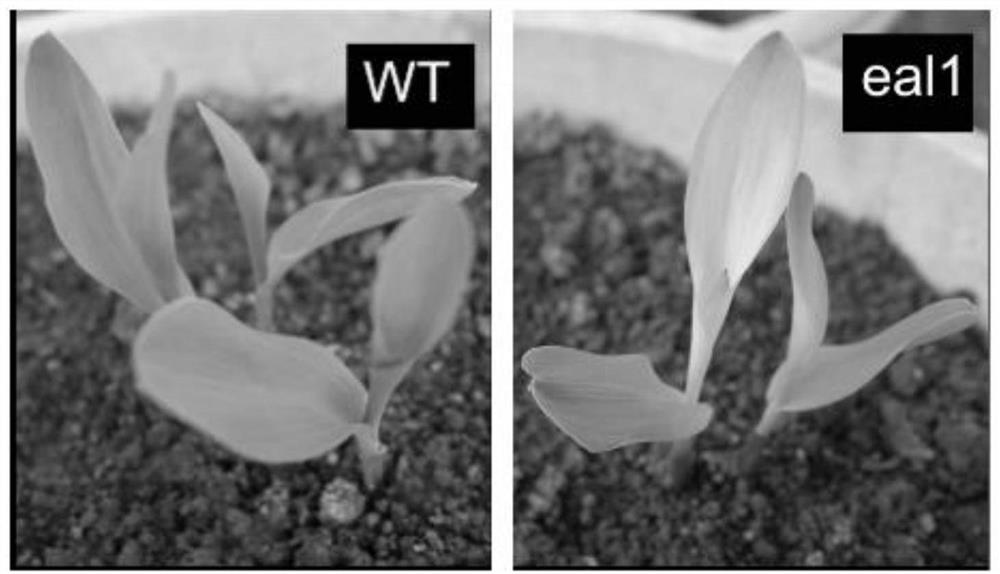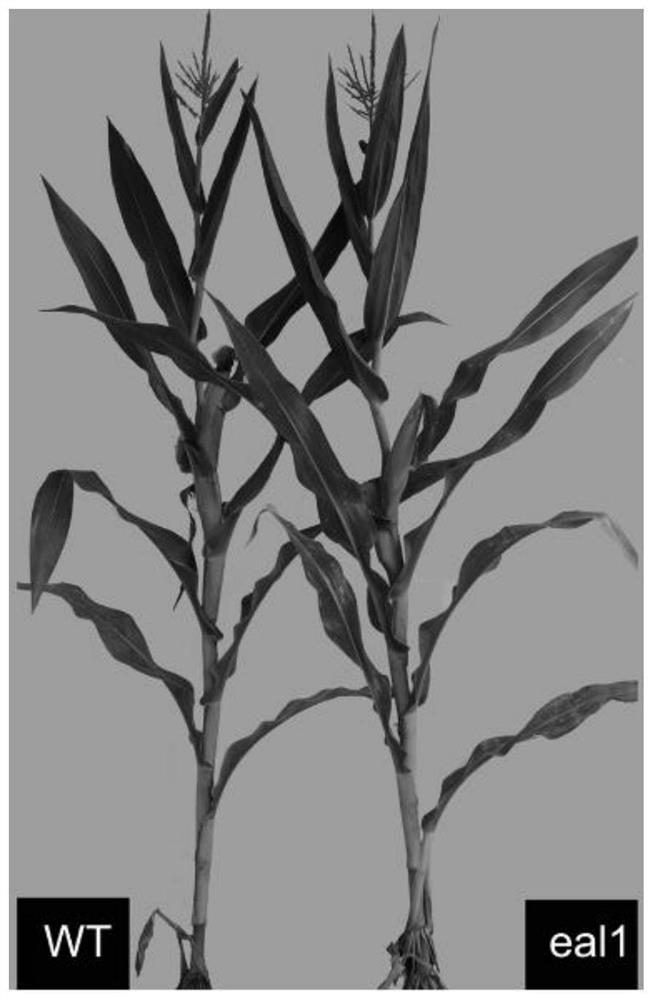A maize seedling yellow and white leaf gene and its encoded protein and application
A gene and protein technology, applied to the use of the gene and protein, in the field of yellow and white leaf genes of maize seedlings, can solve the problems of reducing the non-lethal ratio of transgenic pollen, and achieve the effect of obvious characteristics, easy identification and stable inheritance
- Summary
- Abstract
- Description
- Claims
- Application Information
AI Technical Summary
Problems solved by technology
Method used
Image
Examples
Embodiment 1
[0053] Example 1 Obtainment and Genetic Analysis of the Yellow and White Leaf Color Mutant eal1 of Maize Seedlings of the Present Invention
[0054] (1) Obtaining and phenotypic identification of the corn seedling yellow and white leaf mutant eal1 of the present invention
[0055] In 1996, the applicant used a returnable satellite to carry Chuandan No. 9 corn seeds to carry out space mutagenesis. After the space mutagenesis, the Chuandan No. 9 seeds were self-crossed for 8 generations, and a seedling leaf color mutation material was accidentally obtained. , the color of the mutant material is yellow or even white after emergence (hereinafter referred to as: yellow and white leaves), and it quickly changes to normal green in the later stage. The inventor named the mutant material: eal1. The sister plants from the same panicle line with normal leaf color and no separation of leaf color in the selfed offspring were used for conservation and served as the control WT.
[0056] The...
Embodiment 2
[0062] Example 2 Map-based cloning of the zmeal1 mutant gene in maize
[0063] (1) Fine mapping of maize zmeal1 gene
[0064] The F2 population obtained in Example 1 was used as a genetic mapping population, and the genomic DNA of leaves of mutant individual plants in the population was extracted by the CTAB method for genotype identification. By searching the MaizeGDB public database (http: / / www.maizegdb.org / ), 366 pairs of SSR markers covering the entire maize genome were screened. Polyacrylamide gel electrophoresis and agarose gel electrophoresis were used to identify the polymorphisms of these SSR markers between the mutant eal1 and the inbred line B73.
[0065] Firstly, 96 individual plants with leaf color mutation in the F2 population were used for initial mapping, and the mutant gene was located on the short arm of chromosome 4. The mutated gene was positioned between the polymorphic molecular markers InDel2 and InDel19 through encrypted polymorphic markers on chromos...
Embodiment 3
[0072] Example 3 Genotype Identification Test of Maize zmeal1 Mutant Gene Locus Using Specific Primers and Enzyme Cutting Methods
[0073] Example 2 verified the above-mentioned 7 SNP variations and a 3bp deletion at the genomic DNA level. Based on the above variation information, an enzyme-cut amplified polymorphic sequence marker BeCaps1 in the ZmSig2A gene was developed (see Table 1), and the genomic DNA was amplified using the primer BeCaps1, and the reagent used was KOD FX (TOYOBO, Code No.: KFX-101); the amplification program was: pre-denaturation at 94°C for 5 minutes; denaturation at 98°C for 10 seconds, annealing at 59°C for 30 seconds, extension at 68°C for 1 minute, and 34 cycles; extension at 68°C for 5 minutes; end program at 12°C. The resulting amplified PCR product was subjected to agarose gel electrophoresis after being digested with NruI.
[0074] Results (see Figure 7 ) the genotype is dominant homozygous ZmEAL1ZmEAL1, the band size after enzyme digestion is...
PUM
 Login to View More
Login to View More Abstract
Description
Claims
Application Information
 Login to View More
Login to View More - R&D
- Intellectual Property
- Life Sciences
- Materials
- Tech Scout
- Unparalleled Data Quality
- Higher Quality Content
- 60% Fewer Hallucinations
Browse by: Latest US Patents, China's latest patents, Technical Efficacy Thesaurus, Application Domain, Technology Topic, Popular Technical Reports.
© 2025 PatSnap. All rights reserved.Legal|Privacy policy|Modern Slavery Act Transparency Statement|Sitemap|About US| Contact US: help@patsnap.com



